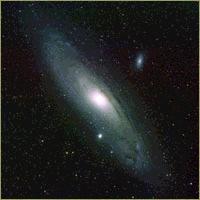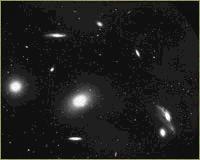|
|
|
Galaxies, Clusters, and Superclusters
|
|
 Andromeda Galaxy
Andromeda Galaxy
 Galaxy Messier 33
Galaxy Messier 33
 Large Magellanic Cloud
Large Magellanic Cloud
|
Galaxies are the building blocks of the universe. Clusters of galaxies,
and clusters of clusters of galaxies, called superclusters, make up the
structures in the geography of the universe. In this section, we'll explore
these structures and take a look at our address on these scales.
Galaxies are titanic swarms of tens of millions to trillions of stars.
Between the stars, there can be vast interstellar clouds of gas and dust.
Spiral galaxies have a thin, pancake-shaped disk, with a spherical bulge
at the center. Within the disk, the brightest stars trace out the characteristic
spiral pattern. Elliptical galaxies are shaped roughly like watermelons,
some round and some elongated. Large galaxies are approximately
100 thousand light-years across (a light-year is the distance light travels
in one year: about six trillion miles). In rather plain fashion, the smallest
galaxies are called dwarfs while the largest are called giants.
Our Milky Way Galaxy is one of three large galaxies in the Local Group
of Galaxies. The other large galaxies are the Andromeda Galaxy, and Messier
33 (the 33rd entry in Charles Messier's catalog of fuzzy things in the
sky). Also in the Local Group are a couple dozen dwarf galaxies. Several
of these dwarf galaxies are satellite galaxies, orbiting around the large
galaxies. The Milky Way has two prominent satellite galaxies, called the
Large and Small Magellanic Clouds. (The Magellanic Clouds are visible on Earth only from
the southern hemisphere; their existence was recorded by the voyage
of Magellan).
The Local Group is a small clustering of galaxies, a few million light-years across. Larger clusters of galaxies can contain hundreds of galaxies.
Galaxies within a cluster are generally considered to be bound together by
their mutual gravitational pulls. They each orbit around their common center
of mass. Because the density of galaxies is high within clusters, galaxy
collisions occur. One such collision can be seen in the lower right of
the image of the Virgo cluster below.
 Galaxies at the center of the Virgo Cluster of Galaxies
Galaxies at the center of the Virgo Cluster of Galaxies
|
|
The largest nearby cluster of galaxies is the Virgo Cluster, named after
the constellation in which we see it. The Virgo Cluster contains about
a thousand galaxies, and spans about ten million light-years. Several giant
elliptical galaxies inhabit the central regions of the Virgo Cluster. These
giants are believed to have formed through the merging of other galaxies. The
density of large galaxies in the Virgo Cluster is about ten times greater
than that in the Local Group.
The enormous gravity of the Virgo Cluster makes it the center of a larger
structure, called the Local Supercluster. This collection of nearly 100 clusters, and thousands of galaxies, stretches across a hundred million light-years. The Local Group is just a tiny member of the
Virgo Supercluster, located on the outskirts. Just as we have found that Earth
is not the center of the solar system, and the Sun is just another star
in the Milky Way, so too have we found that our galaxy holds no special place in the universe.
|
 Galaxies observed in the Hubble Deep Field image
Galaxies observed in the Hubble Deep Field image
|
The image to the right is from the Hubble Deep Field, a special observation
made with the Hubble Space Telescope. With this image we can see farther into the
universe and uncover more galaxies than perhaps any other observation
ever made. From the hundreds of galaxies we can see in this very small
patch of sky, we can estimate that there are about 50 billion galaxies
in the universe.
|
Copyright 2001, Ken Castleberry,Jr
Webmaster: Cat Castle
Revised: 1/19/02/
|
|